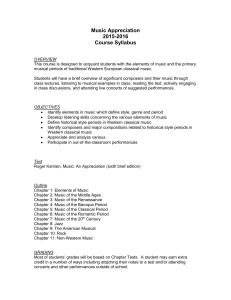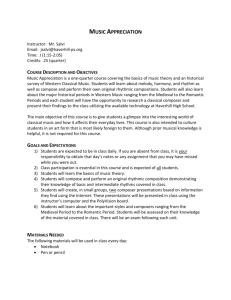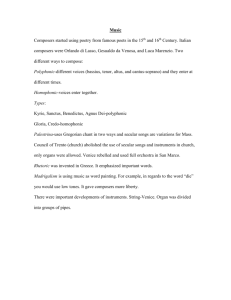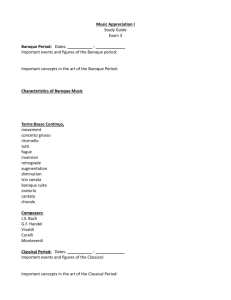21st Century Skills Approach to Teaching Music History: Project
advertisement
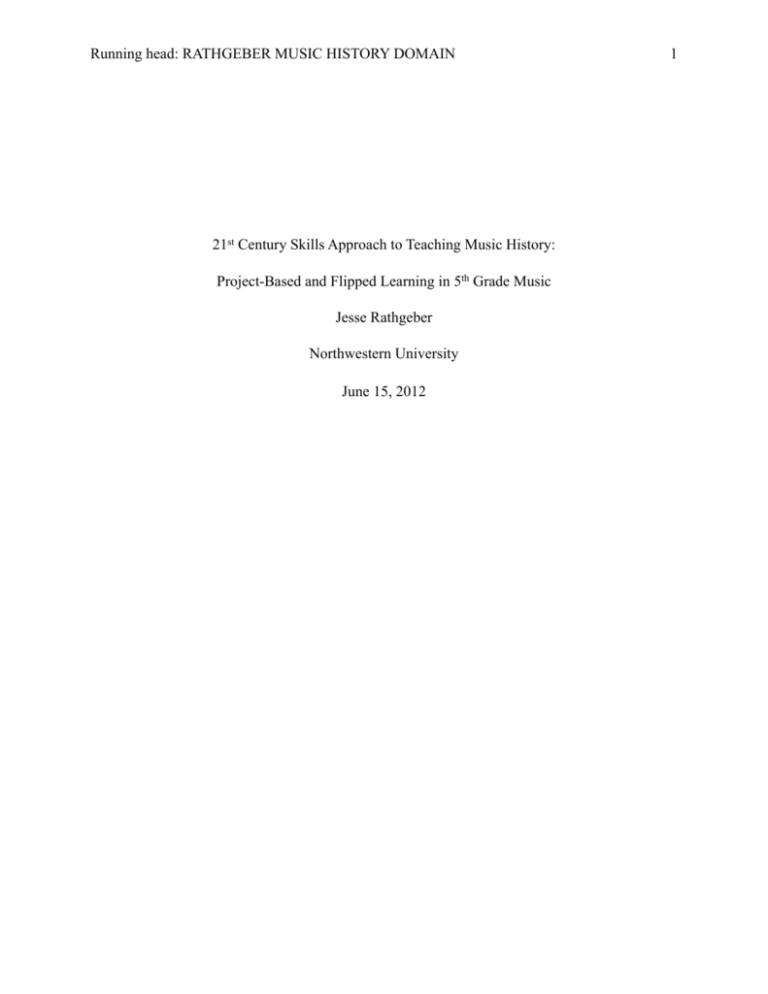
Running head: RATHGEBER MUSIC HISTORY DOMAIN 21st Century Skills Approach to Teaching Music History: Project-Based and Flipped Learning in 5th Grade Music Jesse Rathgeber Northwestern University June 15, 2012 1 RATHGEBER MUSIC HISTORY DOMAIN 2 Prelude: Does Teaching Western Art Music History Have to Be Boring? History classes can be an enjoyable journey through time for students. However, history is often presented in a dry and/or non-experiential manner. Music history can be one of the areas of study that the second paradigm often holds true. When I take a look back on the my own music education, most lessons that focused on composers and their historical context were the least enjoyable and most quickly forgotten. I am surely not alone. In a 2007 study, Campbell, Connell, and Beegle found that one area of concern middle schooler noted about their music classes was “boring music” they learned about that did not relate to their musical taste. So, why is it that music history and “classical” music, in general, is regarded as boring areas of study for so many students? The problem could lie in the way in which such lessons are presented. How can music educators expect students to enjoy learning about and retain information on music history when, all too often, it is presented in the form of outdated, lecture style lessons that do not seem relevant to students’ lives, their educational needs, and personal preferences? For my music history domain, I tired to find a way to present Western Art Music History to my students experientially in an interdisciplinary manner so that they would find enjoyment and relevance in what they learned. I regularly include classical music in my lessons and fifth grade students are expected to experience a survey and display a basic level of understanding about four periods of Western Art Music History; Baroque, Classical, Romantic, and 20th Century/Modern. Yet, I have always struggled with marking these types of lesson highly engaging. Therefore, I developed some methods, tools, and projects that would assist me in teaching this part of my curriculum in a way that would be well received by my students and also leave them with a developing body of knowledge. In doing this, I attempted to change the way I RATHGEBER MUSIC HISTORY DOMAIN 3 taught to help develop my students’ “21st Century Skills” of collaboration, critical thinking, making global connections, self-direction, and use of technology as a learning tool, as described by Ravitz, Hixson, English, and Mergendoller (2012). Two methodologies utilized as guiding concepts to achieve these ends are Project-Based Learning (Solomon, 2003) and flipped learning as advocated by Kahn (2011). RATHGEBER MUSIC HISTORY DOMAIN 4 21st Century Skills Approach to Teaching Music History Project Scope and Components The overall scope of this project rapidly grew as I began to conceptualize the impact I wanted to have on my classroom, students, and curriculum. The project started with a simple school website about music history. Soon, I integrated our recorder performance curriculum by creating and using recorder arrangements of popular classical works. Next, I began to generate interactive whiteboard flipcharts to present mini-lessons about periods of music history. Finally, with the help of our school technology and information literacy coaches, I developed a ProjectBased Learning inspired, student-created music website. The complete scope and its interconnected nature can be seen in a separate MindNode map. School Music History Website As I adapted concepts of “flipped learning” (Kahn, 2011; Koller, 2011) through the use of my school music website, providing lessons and concepts for students to explore at home and/or during centers, I discovered that my students were beginning to go online to explore the website independently. They were coming back into the classroom with the basic knowledge that I would have originally taught in class, and were prompting deeper discussions. Parents would mention how their students had spent all night playing along with recorder lessons or learning more about Holst’s “The Planets.” These findings made me reconsider how I presented information in class. I realized that I could get my students to independently engage with music class curriculum if it was presented on my website in an enjoyable manner. As a result, I decided to produce a music history website to highlight composers, their works, and their historical context for my students RATHGEBER MUSIC HISTORY DOMAIN 5 to use as an at-home and center time tool. So, cm-musichistory.wikispaces.com was born and continues to grow. When creating the website, I first set up the overall structures of main and sub-pages (Figure 1). For each of the historical periods, I created a main site with basic information, a characteristics page, and pages highlighting a few prominent composers of the period. The characteristics page included characteristics of the period, some popular styles of song forms, popular instruments, and an artwork that displayed similar characteristics. Each composer page included short, kid friendly biographic information, pictures/portraits, suggested works, a link to a playlist of the composer’s music, and four embedded YouTube performances of some of the composer’s works performed by a diverse body of musicians. I made an effort to gather my information for each page from common sources that my students would be making use of, mainly in the form of textbooks and other survey guides of classical music. Primarily, I made use of Osborne’s (1984) Dictionary of Composers, Stanley’s (2007) Classical Music: The Great Composers and Their Masterworks, Kamien’s (2008) Music: An Appreciation (9th ed.), Grout and Palisca’s (2001) A History of Western Music (6th ed.), and Sherman and Seldon’s (1997) oddly enjoyable and useful The Complete Idiot’s Guide to Classical Music as my resources. Adding an element of interactivity to the website, I made extensive use of links to outside resources that would allow my students to independently explore and dive deeper into the related information. For example, a composer’s birth and death places were linked to maps via GoogleMaps and unfamiliar instruments and concepts were linked, when applicable, to pictures or websites that are related. Finally, I made an attempt to accommodate my students’ odd RATHGEBER MUSIC HISTORY DOMAIN 6 fascination with how composers died and other afflictions they may have had by making text links to a children’s health website that described adult diseases and problems in child-like ways. Figure 1. Overall website structure for the school website Student websites Another major component of this project was actually having my students research and create music history websites. To do this, I was lucky enough to have the help and expertise of our technology coach, Robert Hanrahan, who assisted me in generating a basic website structure (Figure 2) as a template for the students to edit. He also helped me tackle the task of assigning site-level permissions to each student and introduced me to some of the concepts of modern Project-Based Learning (Simons, 2003), which led to the forming of collaborative groups, research targets, and many of the other facets of this project. For the project, students had to collaboratively research, input their findings, and plan out how the information would be RATHGEBER MUSIC HISTORY DOMAIN 7 displayed on their websites by making use of web development tools like embedding and linking. The groups needed to use their critical thinking skills to process sometimes conflicting research and provide the following information for their websites: musical characteristics, exemplar composers, a few works by these composers, videos relating to the period, important or interesting historical events that occurred, at least one piece of artwork from the period that displayed similar characteristics as the music, and cited sources. Figure 2. Overall website structure for student websites For the first portion of their website project, students researched the Classical period. I assessed these Classical websites by making use of a checklist that was provided to the students and by posting the checklist with comments to a document that only the group could access. Students were encouraged to make revisions as they also started their work on the next period’s RATHGEBER MUSIC HISTORY DOMAIN 8 webpage. For the Romantic and Modern periods, the constraints and specific directions were decreased to allow for student creativity and personal choice. The final part of this project was for each student to independently create a page for one Modern period composer that they selected from a list or chose based on their research. Again, the actual requirements for these pages were kept intentionally loose. Student did get very creative with how they displayed their information and actually began conversations with Mr. Hanrahan about web development. Also, the commenting feature on the website was enabled for this step in the project to encourage students to critique and assist each other. Classroom Experiences and Connections to Recorder Curriculum The final portions of this music history domain project were related to what occurred in the classroom (Figure 3). First, I developed mini-lessons to teach the basic characteristics and context of each historical period. In these mini-lessons, I made use of an interactive whiteboard software called ActiveInspire to create audio and visual teaching tools. These provided students with a 10 to 15 minutes survey of general information and musical works about the musical periods to guide their research and thinking. For the remainder of the 45 minutes of music class for the week, students went through a variety of activities to help solidify or extend their understanding of the concepts taught in the mini-lessons. Some of the learning activities were center-based in which students would explore music through videos, iPod listenings, and websites for independent discovery. During some classes, students learned recorder versions of famous classical works that I had arranged for them to integrate required performance targets. The final set of activities that students would encounter RATHGEBER MUSIC HISTORY DOMAIN 9 during this project were experiential based and involved students moving, using focused listening skills, or composing based on concepts they had learned about in class. Figure 3. Classroom components of the project Finally, each period ended with a debriefing discussion about what students learned and a listening activity that helped students relate music of each period to modern, popular music styles. One example of such a lesson occurred as we were listening to Coldplay’s “Paradise” as a connection to the music of Brian Eno, as he produces a great amount of Coldplay’s records. As students listened, they began to spontaneously shout out connections to every other musical period. RATHGEBER MUSIC HISTORY DOMAIN 10 Coda: A Reflection This domain project was very rewarding and, at times, very tricky. Nonetheless, it has already had a major impact upon how I intend to plan lessons in the future. By integrating ideas and talents of other educators, I was also able to expand my knowledge of progressive education methodologies and ideologies. By working closely with classroom teachers, information literacy coaches, and technology coaches, the reach of a music curriculum can become expansive. Not only can the music curriculum reach into other non-academic areas, but also, with higher buy-in by other staff members, curricular planning can quickly become more interdisciplinary and holistic. However, the most amazingly worthwhile outcome of this project is the impact it had directly on my students’ learning and enjoyment of classical music. Through each step of the project, I attempted to make the music cool and show its relationship to the music that my students enjoy, while also avoiding every chance to make judgment calls about the quality of the music. By showing students a composer’s works, how they crafted their compositions, and the socio-cultural context that they lived and worked in, I attempted to show them why classical music is unique without telling them that they have to love every work and value it above any other style of music. Also, by “flipping” my classroom the way that Kahn (2011) advocates for, I opened up class time for deep, student-directed discussions that were engaging and educational to myself and the students. By attempting to integrate “21st Century Skills” (Ravitz et al., 2011), I placed a lot more control over the learning process into the hands of my students, which they seemed to relish. By fostering collaboration, critical thinking, and self-directed learning through the use of Project-Based Learning (Solomon, 2003), I saw my students encounter challenges RATHGEBER MUSIC HISTORY DOMAIN 11 together, grow, and create amazing websites that displayed their learning. The students even independently engaged in revisions to their websites and some are continuing their work over the summer. Finally, by adding in the always “hip” and “cool” allure of technology, I helped my students see how technology can be a tool for their learning as well as for their entertainment. The overall impact of this project will not be felt by me, directly, since the fifth grade students will bye moving to middle school in August. However, I know that what they experienced and how they grew was meaningful and valued by them because so many ended their time in elementary school discussing this very thing and/or comment on their websites. One student put it this way: “At first, I thought, ‘how boring, I hate that old stuff!’ But now, its so cool how the music I like is kind of connected to stuff from a long time ago. The best thing about it was that we kind of had us figure it out on our own, so we had to think and pay attention when we were in class and when we did the research stuff. I feel like I just solved a big puzzle!” (Student, personal communication, June 3, 2012) RATHGEBER MUSIC HISTORY DOMAIN 12 Resources Campbell, P. S., Connell, C., & Beegle, A. (2007). Adolescent’s expressed meanings of music in and out of school. Journal of Research in Music Education, 55(3), 220-236. Kahn, S. (2011, March). Salman Kahn: Let’s use video to reinvent education [Video file]. Retrieved from http://www.ted.com/talks/ salman_khan_let_s_use_video_to_reinvent_education.html Koller, D. (2011, December 6). Death knell for the lecture: Technology as a passport to personalized education. The New York Times, D8. Retrieved from http://www.nytimes.com/2011/12/06/science/daphne-koller-technology-as-a-passport-to-\ personalized-education.html?pagewanted=all Ravitz, J., Hixson, N., English, M., & Mergendoller, J. (2012). Using project based learning to teach 21st century skills: Findings from a statewide initiative. Paper presented at annual meetings of the American Education Research Association, Vancouver, BC. Retrieved from http://www.bie.org/research/study/PBL_21CS_WV Solomon, G. (2003). Project-based learning: A primer: When students are challenged to get to work solving real-life problems, the world becomes a classroom. Here we offer a guide to getting started. Technology & Learning, 23(6), 20.
